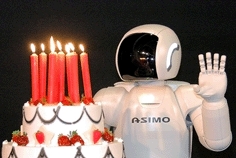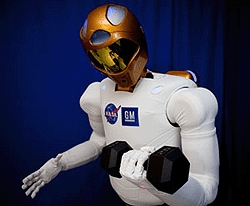Prepare the robo-cake, light the robo-candles: the Little Robot that Could is ten years old. Asimo, Honda’s cute walking/running/dancing ‘droid, has hit its (the temptation to write ‘his’ is very strong) first decade. And frankly, I still find the videos of the thing - which looks like a miniature astronaut and walks like an unnaturally confident toddler - slightly unnerving to this day.

Robot culture is huge in Japan. Where the UK, US and Europe tend to think of robots as industrial machines, the Japanese continue to develop ever more lifelike-seeming synthetic people, with almost-natural movements and almost-lifelike features, skin and hair; the push for the science-fiction ideal of robot pop stars, robot companions and the future-cliché of the robot butler is a very real aspiration.
There’s a phenomenon that computer animators call the Uncanny Valley. It’s where renditions of the human form are extremely realistic but miss complete photorealism very, very slightly; the eyes are a little too glassy, maybe, or the skin a bit waxy, or the movements just slightly too mathematically perfect. It gives people the creeps, and it’s why most of the animation studios go for cartoony depictions of people; they’re easier to relate to.
Japanese culture has different aesthetics, and perhaps this is why lifelike robot development flourishes there in a way that it doesn’t elsewhere. Asimo misses the Uncanny Valley in its looks, but as Honda’s engineers work on its mechanics, control systems and interface, its movements become steadily more eerily lifelike. Is it just me, or is anyone else wondering what’s going on behind that featureless black face-screen?
The astronauts aboard the International Space Station may soon have their own Uncanny Valley moment, as a robot designed by GM, named Robonaut 2 (R2 for short, presumably with apologies to George Lucas) is part of the cargo — or should that be the crew? — of the last Space Shuttle flight to visit its orbit. R2, unlike the dumpy little tripedal plug-shaped droid of the Star Wars films, is a sleek humanoid, with a bronze helmet-like head and matching backpack, a white padded body with seemingly-muscular arms, and dextrous lifelike hands. Equipped with an array of sensors, R2 is a development model for crash test dummies, while its hands could find applications as manipulators for the manufacturing industries.

It’s perhaps fortunate that R2 doesn’t have legs; the torso sits on a fixed pedastal. However, a weightless astronaut coming face-to-visor with this apparition in a cabin lit only by the blue glow of Earthlight could still get a nasty turn. Good job R2 won’t be up there in time for Hallowe’en, really.










McMurtry Spéirling defies gravity using fan downforce
Ground effect fans were banned from competitive motorsport from the end of the 1978 season following the introduction of Gordon Murray's Brabham...